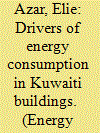| Srl | Item |
| 1 |
ID:
128377


|
|
|
|
|
| Publication |
2014.
|
| Summary/Abstract |
While studies highlight the significant impact of actions performed by occupants and facility managers on building energy performance, current policies ignore the importance of human actions and the potential energy savings from a more efficient operation of building systems. This is mainly attributed to the lack of methods that evaluate non-technological drivers of energy use for large stocks of commercial buildings to support policy making efforts. Therefore, this study proposes a scientific approach to quantifying the energy savings potential due to improved operations of any stock of commercial buildings. The proposed framework combines energy modeling techniques, studies on human actions in buildings, and surveying and sampling methods. The contributions of this study to energy policy are significant as they reinforce the role of human actions in energy conservation, and support efforts to integrate operation-focused solutions in energy conservation policy frameworks. The framework's capabilities are illustrated in a case study performed on the stock of office buildings in the United States (US). Results indicate a potential 21 percent reduction in the current energy use levels of these buildings through realistic changes in current building operation patterns.
|
|
|
|
|
|
|
|
|
|
|
|
|
|
|
|
| 2 |
ID:
177398


|
|
|
|
|
| Summary/Abstract |
Understanding and quantifying the drivers of energy consumption in buildings is an essential step to identify inefficiencies and guide energy conservation efforts and policies. While such efforts are common in western countries, they remain limited in the Middle East and North Africa (MENA) region, particularly in the State of Kuwait. This article presents the first systematic assessment of the drivers of energy consumption in Kuwaiti commercial and residential buildings. It presents a unique hybrid study approach combining data collected from 463 buildings with Building Performance Simulation (BPS) developed and validated to mimic the performance of archetype (i.e., typical) Kuwaiti buildings. Results identify the built-up area and the thermostat cooling setpoints as the main determinants of electric consumption, quantifying the exact relationships between these variables. For instance, a simple 2 °C increase in the thermostat cooling setpoint can lead to a more than 10% reduction in total energy use. Other parameters that are typically known to affect building performance, such as the type of Air Conditioning (AC) systems installed, did not show statistically significant effects. The findings helped derive important recommendations for the Kuwaiti authorities, covering the educational, technological, and policy-related dimensions of the challenges facing the building sector.
|
|
|
|
|
|
|
|
|
|
|
|
|
|
|
|